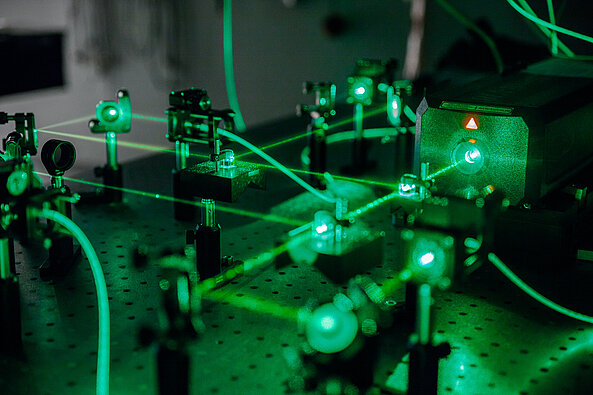
The video cannot be viewed because you have not selected functional cookies.
To view the video, please enable functional cookies in your cookie settings.

Laser Centre is a structural unit of the Faculty of Physics, Mathematics and Optometry of the University of Latvia. Laser Centre maintains active research programmes in atomic physics, molecular spectroscopy, physics and applications of nitrogen-vacancy (NV) centres in diamond and observational astronomy.
Laser Centre consists of four laboratories:
The main focus in atomic physics is on coherent effects in atomic systems such as zero and non-zero field magneto-optical resonances, level-crossing spectroscopy, alignment-to-orientation conversion, electromagnetically induced transparency, and others. Hyperfine structure and light-atom interactions in the presence of electric and magnetic fields are investigated experimentally and theoretically. Experiments are conducted in alkali atomic vapours using a wide range of lasers and signals are modelled using the optical Bloch equations for the density matrix. Applications to measuring electric and magnetic fields are also studied.
Molecule Optical Polarisation Laboratory focuses on investigating the structure and interactions of electronic states in diatomic molecules, specifically in order to optimise methods and to develop solutions for efficient laser synthesis of ultra-cold diatomic ensembles in their lowest rovibronic states. Experiments are based on high resolution (below 0.01 cm-1) Fourier-Transform spectroscopy combined with laser-induced fluorescence; deperturbation treatment and ab initio calculations are applied for obtaining high accuracy experiment-based potentials and interaction parameters. Additionally, a Bruker IFS 125 Fourier-Transform Spectrometer, with resolved linewidths from 0.006 cm-1 to 0.05 cm-1 over the spectral range from 750 cm-1 to 50,000 cm-1 (200 to 13300 nm), respectively, in conjunction with a multi-pass absorption cell offers possibilities to determine the low concentration of small molecules.
Nitrogen-vacancy centres in diamond present an atom-like system with unique properties that make them interesting for magnetometry applications with high spatial resolution as well as quantum computing. They also raise many fundamental physics questions that can be studied with the help of experiments and theory. Our efforts are centred on magnetometry, magnetic field imaging, dynamic nuclear polarisation and spin dynamics. Main advantages of the NV-diamond system are the possibility to bring it into close proximity to many kinds of samples since the diamond matrix is chemically and mechanically durable, as well as non-toxic. In addition, measurements can be made over a temperature range from cryogenic to hundreds of degrees Celsius and the probe itself can be as small as a cubic micrometre.
Laboratory of astrospectroscopy participates in observational campaigns to collect spectra of stars and preplanetary nebulae in the optical and infrared wavelength regions. The focus is on understanding nucleosynthesis inside stars, the dynamics of stellar atmospheres and circumstellar environment, and related questions of astrophysical interest. In Laser Centre, the high-resolution emission spectra of neutron-capture elements important in astrospectroscopy are produced in hollow cathode discharge allowing to identify new lines, obtain hyperfine structure patterns and determine magnetic dipole interaction constants.
We offer bachelor's, master's and PhD positions, as well as work in the implementation of scientific projects.
- A. Liepa’s Correspondence Mathematics School
- Electronic Structure group
- Chair of Physics Education Research
- Laser Centre
- Laboratory of Magnetic Soft Materials
- Nanoelectronics Theory Group
- Department of Optometry and Vision Science
- Laboratory of Statistical Research and Data Analysis
- Institute of Numerical Modelling

 Academic Centre
Academic Centre